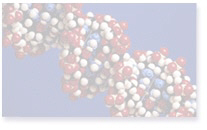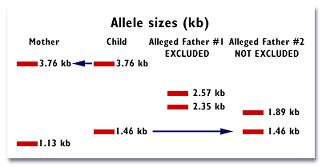|
| |
DNA Paternity Testing
Background and Technical Information
What Are Genes?
The human body consists of trillions of cells. Most of these cells have a
nucleus, or center. The nucleus contains genes, the functional units of
heredity. The genes are grouped into separate bundles called chromosomes.
 There
are 46 chromosomes inside every cell in the body. Twenty-three of these
chromosomes came from the biological mother and 23 came from the biological
father. Chromosomes are named by a letter "D" followed by a number [i.e.,
chromosome #1 is named D1; and, chromosome #2 is named D2, etc.]. Genes are
named by the chromosome number, and by the location that the genes occupy on the
chromosome. A DNA Parentage Test report identifies the genes that were analyzed
during the process of testing. When the results refer to D2S44,
the gene analyzed was on chromosome #2 at locus 44. There
are 46 chromosomes inside every cell in the body. Twenty-three of these
chromosomes came from the biological mother and 23 came from the biological
father. Chromosomes are named by a letter "D" followed by a number [i.e.,
chromosome #1 is named D1; and, chromosome #2 is named D2, etc.]. Genes are
named by the chromosome number, and by the location that the genes occupy on the
chromosome. A DNA Parentage Test report identifies the genes that were analyzed
during the process of testing. When the results refer to D2S44,
the gene analyzed was on chromosome #2 at locus 44.
The Chemistry of Genes
 Twenty-six
letters of the alphabet are the basic units of the English language. Words and
sentences are formed from these 26 letters. Genes on the other hand are formed
from only 4 chemicals, or bases. These bases are named: (1) adenine, (2)
cytosine, and (3) guanine and (4) thymine. Like the letters of the alphabet that
form sentences, these 4 bases form long gene fragments called deoxyribonucleic
acid, abbreviated DNA. The length of the gene fragments can be determined by the number of
bases these gene fragments contain. When the gene fragment on a DNA Parentage Test
report is 2.34 kilo bases that means the gene fragment consists of 2,340 bases
[kilo base = 1,000 bases]. Twenty-six
letters of the alphabet are the basic units of the English language. Words and
sentences are formed from these 26 letters. Genes on the other hand are formed
from only 4 chemicals, or bases. These bases are named: (1) adenine, (2)
cytosine, and (3) guanine and (4) thymine. Like the letters of the alphabet that
form sentences, these 4 bases form long gene fragments called deoxyribonucleic
acid, abbreviated DNA. The length of the gene fragments can be determined by the number of
bases these gene fragments contain. When the gene fragment on a DNA Parentage Test
report is 2.34 kilo bases that means the gene fragment consists of 2,340 bases
[kilo base = 1,000 bases].
All children have a biological mother and a biological father. For each gene in
the child, there is one genetic variant size that came from the father and one
genetic variant size that came from the mother. A DNA Parentage Test determines
and examines the genetic variant sizes [i.e. allele sizes] found in the mother,
the child and the alleged father.
In the sample report shown below, the upper gene fragment in the child (3.76-kb
size) matches the upper gene fragment size of the mother. The child received the
lower gene fragment (1.46-kb size) from his/her biological father.

The alleged father #1 has gene fragment sizes different from those found in
the child. Therefore, the alleged father #1 cannot be the child's biological
father. The alleged father #2 has the same gene size fragment as that found in
the child (i.e., 1.46 KB). He could be the child's biological father. The
probability that he is the child's biological father depends on the frequency
with which this gene fragment is found in the male population. The fewer men who
have this gene fragment size, the greater probability that the tested man is the
biological father of the child.
This process is repeated several times and each time a different gene is
analyzed. The accuracy of the DNA test results depends on the extent of the DNA
Testing process. With sufficient testing, DNA technology provides an extremely
powerful method of discriminating between fathers and non-fathers.

|